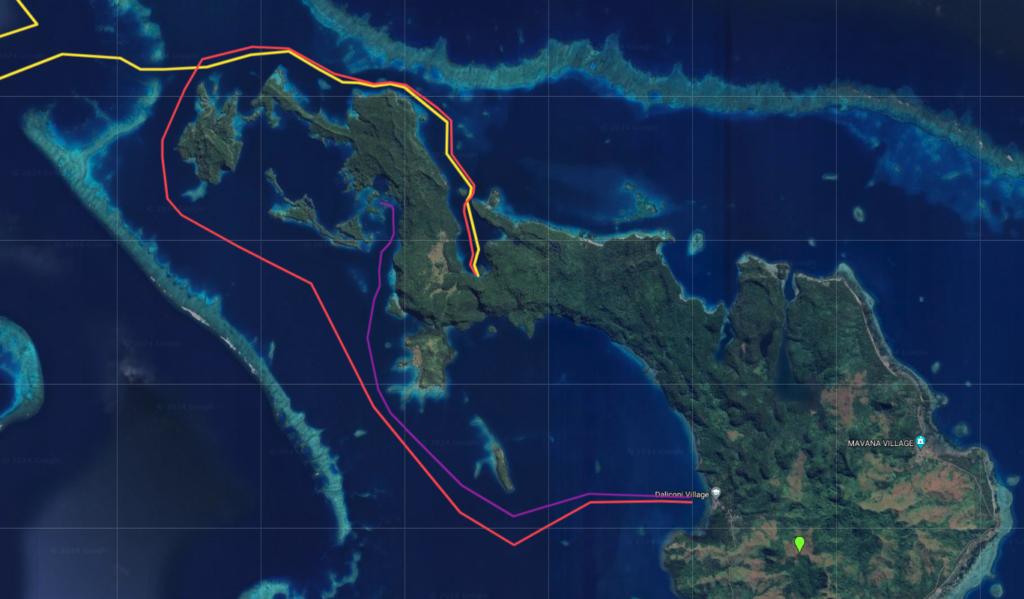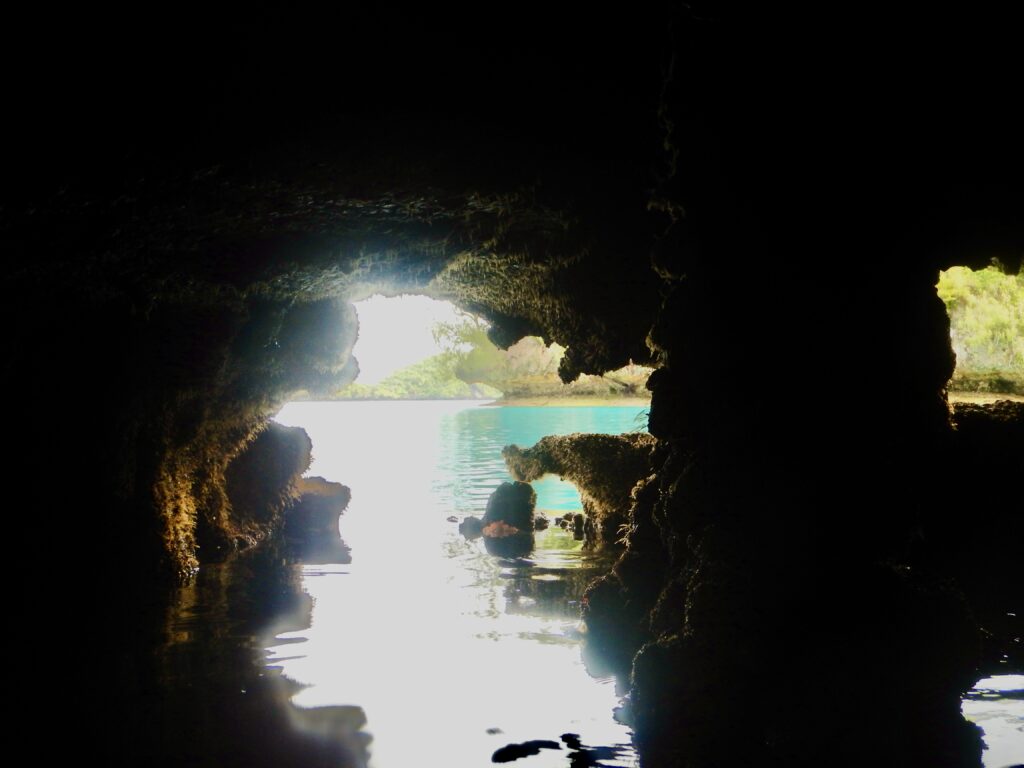We had been watching the weather, looking for the right conditions to make the passage from Qamea to Vanua Balavu Island, about 70nm southeast. If we do about 7 knots, this is a 10 hour passage, too much to do in a day and still arrive when it is light. But it is an easy over night passage and the conditions looked perfect on July 25, so at 1800 hours, we pulled the anchor and left. It was perfect conditions all night and we sailed at mostly 8 to 10 knots so we arrived a bit early. We did circles and figure 8s until it was light enough to enter the reef.

We motored in through the pass, following a few minutes behind another boat. It is nice to be able to watch someone else, see where they go and if they have trouble. All good, no problems. But we did need to navigate using a combination of charts and visual, as there were rocks that were not on the charts. Our headphones worked well, with me up front spotting things and Peggy watching the charts and driving. We dropped the hook in Nanai Bay, at the end of the yellow line below.

There were several other boats there, including our friends on Taihoa, a catamaran about our size that made the night passage Qamea with us. They had broken the gooseneck bolt (it holds the boom to the mast – pretty important!) during the night. As luck would have it, I had a big bolt that was a hair small, but good enough until they could get a perfect fit.
The next day Peggy & I took a long hike. We crossed the narrow neck of the island and then went up through a plantation that raises sheep, horses, pigs, chickens and has a large fruit and vegetable garden.

The plantation provides jobs and homes for a number of families.






We had several great days in Nanai bay, hiking, swimming and getting to know other cruisers better. On July 29, it was time to move on. But first, we had to get the anchor up. Usually, this is a 5 minute job. This time it took over an hour.
This bay has lots of coral on the bottom and if you drop the anchor in the normal way, the chain will scrape over the coral and do a lot of damage. So you ‘float the chain’ by attaching a number of floats on 10 to 20 ft lines to the chain to keep it off the bottom. When you pull anchor, you bring up some chain, remove a float, bring up more, remove a float, etc. We normally use two to four floats, depending on the depth and length of chain.
When we started pulling the chain, we found that, due to wind and currents having spun us in circles for 3 days, the float lines had gotten wrapped up in each other and it was a mess. I had to get in the water and sort it out before any floats could be removed. But the water was calm, 80 degrees, very clear, lots of colorful fish, … so it was not so bad. I got to spend a bit more time in paradise!
Once that was done, we sailed back up over the top of the island (red track on the map), heading for an idyllic place called Bay of Islands. But first, we had to go to the town of Dalconi to do Sevu-Sevu, paying our respects to the local people and their ‘head man’.

We did sevu-sevu with the head man and spent some time talking to him about the challenges of the town. They do have a primary school but no high school so kids need to go to boarding school on another island for high school. This can be expensive and difficult for families. Then there are few jobs for the kids when they finish HS so many move away to bigger cities on the two big islands in Fiji. It also feels a little strange to be in a village with families with young kids, nobody age 13 to 18, a few older couples and a number of older people whose family have moved away. That’s just life in many of the villages.

After sevu-sevu, we sailed back up to the Bay of Islands (purple track).
Bay of Islands is a truly special place. Many small inlets with ‘mushroom islands’ dotting the area. Warm, clear water, reefs full of fish and coral, caves to explore in the kayak… A place we will always remember.


This is a great snorkeling area with clear water and lots of coral and fish. We were in the water a lot for a few days.


It is also a kayaker’s paradise. With water this clear, you could see down 20 ft in some areas. All the islands and sheltered lagoons made the water very calm with little wind to create waves or push you in the wrong direction. And tons of caves to explore!







There were interesting places to explore everywhere we paddled. Here, a narrow bridge joins two small islands with a shallow passage underneath.
One evening we invited our cruising friends from Master Plan, Salsa, Chez Nous and Taihoa over for sundowners. It was a great evening of toasts and stories for the 14 of us!
On August 1, it was time to prepare to leave Vanua Balavu. On the way out of the bay, we hit a baumie with the port keel. It shook the hole boat. Luckily, we were not moving very fast and the damage was not too bad and we could sail just fine until we had an opportunity to haul out and fix it nearly a month later.

After making sure the boat was still OK to sail, we went up over the top of the island again (green track on the map) and headed to Lomaloma, the main town. We found quite a few other cruisers and anchored with them near the small town of Susui.

We did sevu-sevu with the wife of the head man because he was away for a few days. The next morning one of the locals took a number of cruisers into Lomaloma for provisioning. It worked out well because he had a fast boat and knew where he could go between all the baumies.
The ‘grocery stores’ were just a big room attached to someone’s home. There was a freezer, fridge and lots of shelves. Sometimes there was a large chalkboard listing items and prices, but many items on the board were not in stock, and there were many things they did have that were not on the board. So you learn to just ask about everything on your list. The lady behind the counter knows exactly what she has and where it is. We got just about everything we wanted, including fuel for our dinghy which was getting a bit low.
The next post will be about our passage to Fulanga and the people we met there. As one of the outer Fijian Islands, they have their own unique culture and are very self-reliant. All about that next time!
What a beautiful and wonderful adventure you had!
I am so enjoying you adventures! And the photos are great!
As I am not a sailor, I look up a few terms as I read. I can’t find “baumie.”
I assume it is a bit of rock or coral under the surface, to do the damage you describe.
Praise God the damage wasn’t disabling!
I can’t wait d
For the next installment!
Yes, a baumie is also called a coral head. They often sit just below the low tide water level and can be anywhere from a few inches across to several meters wide. They are often very tall and thin with the top continually growing up towards the surface if the ocean floor is subsiding.
Pat